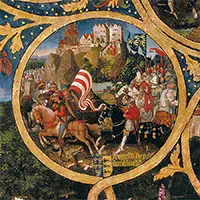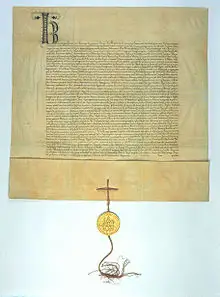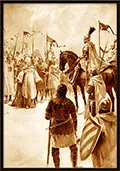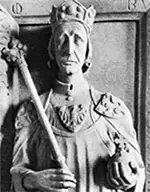The Babenberg Succession Conflict
In the ruling history of Austria, the bridge between the House of Babenberg and the House of Habsburg was a succession controversy. 
The first Margrave of Austria was Leopold I (right), who founded the House of Babenberg in 976. A series of his successors followed him as ruler of Austria. 
One of his descendants was Henry II, who assumed the title of margrave in 1141. Henry had fought in the Second Crusade and barely survived defeat at the hands of the Seljuk Turks at the Battle of Dorylaeum, in 1147, and then was part of the unsuccessful Siege of Damascus, in 1148. One of the few who also survived the defeat at Dorylaeum was Frederick Barbarossa, who was elected King of the Romans in 1152 and then crowned Holy Roman Emperor in 1155. As a measure designed to settle the ongoing feud between the German Welf and Hofenstaufens, Barbarossa, in 1156, gave the Duchy of Bavaria to the Saxon prince known as Henry the Lion. Barbarossa then elevated the margraviate to duchy status and gave it complete independence from Bavaria, by issuing the Privilegium Minus. By the terms of this declaration, Henry II became the first Duke of Austria. As well, the declaration gave Henry the right and power to declare his own successor, even if it was his daughter. When Henry died, in 1177, he passed on his title to his oldest son, who became Leopold V. The next few successions were orderly as well. However, when Duke Frederick II of Austria died, in 1246, he left behind no children. Surviving in his family were both a sister, Margaret, and a niece, Gertrude, both of whom could rightly stake a claim to succession by the terms of the Privilegium Minus, if interpreted liberally. 
By that time, Margaret was the wife of King Ottokar II of Bohemia (right). She was the closest surviving relative of Frederick II, and so she and her husband were proclaimed Duke and Duchess of Austria. Also by that time, Gertrude was married to Roman, Prince of Novogrudok, who claimed the right to rule Austria as the husband of a blood relative of Frederick II. Gertrude and Roman divorced a year after marrying but not before they had had a son, Frederick. He claimed the throne through inheritance from his mother, citing the Privilegium Minus as precedent; his father fell out of the picture. A few years later, Margaret and Ottokar divorced, without having children. Ottokar continued to claim that he was the rightful heir to the leadership of the Duchy of Austria even after Margaret died, in 1267. By that time, Ottokar had become powerful and influential. He was King of Bohemia, Margrave of Moravia, and Duke of Carinthia. He had defeated Hungarian forces at the Battle of Kressenbrunn in 1260, regaining control of Styria. Known as the Iron and Golden King, he Ottokar refused to recognize Rudolf's new status as technically his overlord, and Rudolf completed a series of maneuvers including marrying one of his daughters to Ottokar's son as means of smoothing things over; this worked to a degree, but Ottokar was ultimately not satisfied, and the two sides resorted to war. Rudolf found a welcome ally in King Ladislaus IV of Hungary. The culmination of this struggle was the Battle on the Marchfeld, on Aug. 26, 1278. Rudolf achieved complete triumph, winning the battle and seeing Ottokar killed in the process. Rudolf then became the master of Austria, beginning Habsburg rule, which lasted centuries. |
|
Social Studies for Kids
copyright 2002–2024
David White



 envisioned himself a candidate for the throne of the Holy Roman Empire, which at that time was vacant. However, elected to the imperial throne in 1273 was Rudolf, Count of Habsburg (left), whose grandfather was the most recent emperor,
envisioned himself a candidate for the throne of the Holy Roman Empire, which at that time was vacant. However, elected to the imperial throne in 1273 was Rudolf, Count of Habsburg (left), whose grandfather was the most recent emperor, 
